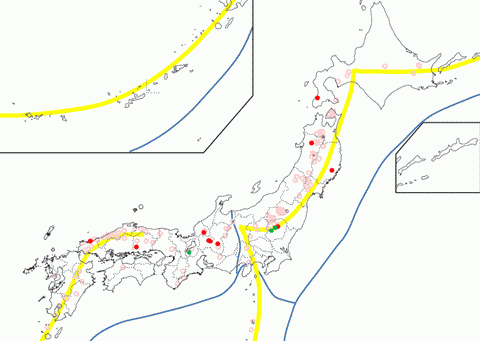Moderately high-T Hydrothermal Deposit
Chemical Process (Liquid-phase Growth) - Open system under ground
Synonym
Mesothermal Deposit, Moderately high-T Hydrothermal Vein Deposit, Moderately high-T Hydrothermal Ore Deposit
Index Minerals
Chalcopyrite, Galena, Sphalerite, Pyrrhotite
Required Geological Setting
Associated metasomatic zones
Pyrophyllite zone, High-T silicified zone, Epidote-Actinolite zone
Occurrence
Vein-type deposit formed by 300-350 degree hydrothermal fluid originated from Acidic (Rhyolite) to Neutral (Dacite, Andesite) magmatic activities by volcanoes such as caldera complexes in volcanic island arc. Origin of hydrothermal fluid is magmatic water from magma, meteoric water, and/or seawater. Meteoric water and seawter are circulated by heat of magma. Typical elements concentrated are Cu, Pb, Zn, and/or As. Host of deposits are volcanic products or basements of volcanoes. Mineral assemblages depends on geological settings of deposits; terrestrial volcano, sumarine volcano, and host rock types in which hydrothermal fluid circulated. The deposit may shift to H-T hydrothermal deposit in the deeper level, and to Moderate-T hydrothermal deposit in the shallower level.

Distribution of Moderately high-T Hydrothermal Deposits described in this site. Green dots are As-free deposits, and red dots are As-bearing deposits. Yellow lines are volcanic fronts.
Mineral Assemblages (Ore)
Chalcopyrite, Pyrrhotite, Pyrite, Galena, Sphalerite, Arsenopyrite
Mineral Assemblages (Gangue)
Quartz, Rhodochrosite, Calcite, Dolomite, Siderite, Barite, Kaolinite
Localities
- Hikida Mine (Cu-Pb-Zn, Siderite)
- Okorogawa Mine (Cu)
- Shizuki Mine (Cu, Marine oxidation)